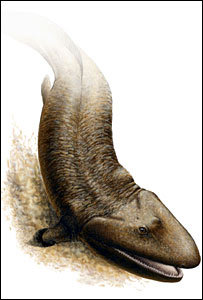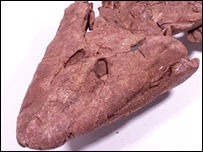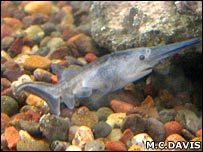Previous research had suggested that fish had made an abrupt genetic jump to acquire land-friendly limbs.
But a US team has now shown this event was not an evolutionary novelty and the transition was far more gradual.
The study, published in the journal Nature, follows the recent discovery of a fossil described as showing the "missing link" between fins and limbs.

|
| ©unk |
| Tiktaalik was described as a missing link |
In 2004, the fossilised remains of the Tiktaalik roseae revealed an animal with fins that were equipped for a life in the water but also for support on land.
The crocodile-like creature, which lived about 380 million years ago, was said to "blur the distinctions" between land- and water-dwelling animals.
Overnight transformation
Marcus Davis, lead researcher of the paper and a scientist at the University of Chicago, said: "The Tiktaalik and other recent fossil finds suggested to us that the structures that really make land animals unique - hands and feet and fingers and toes - just didn't appear out of nowhere."
However, he said, this was in contrast to evidence seen in previous genetic studies, which suggested an abrupt transition from fins to limbs.

|
| ©Daeschler |
| The fossil suggested the move from water to land was slow |
These studies focussed on the Hox genes, which play a vital role in limb development.
Scientists had looked at the expression of the genes in the developing limbs of land animals (tetrapods) and the developing fins of zebrafish, which are often used in embryological studies.
Dr Davis said: "In tetrapods, these studies showed that there were these two separate phases of Hox genes that turn on within the developing appendage. Early in the development there is the first phase, and then there is a second very characteristic phase which plays a role in where fingers and toes form.
"But if you look at a zebrafish during development, it has the first phase, but it doesn't have this second hallmark phase.
"Based on this, the hypothesis was that the second phase of Hox expression must be a developmental and evolutionary novelty that correlated with the origin of hands and feet."
'Weirdos'
However, Dr Davis and his colleagues decided to repeat the studies - but this time using paddlefish, which have a fin pattern similar to primitive fish.
He said: "We found a very clear second phase in their fins - and this tells us that the second key phase of Hox-expression is in fact a much more ancient pattern of development.

|
| ©M.C Davis |
| Paddlefish are similar to ancient fish |
"It seems that some fish have always had this genetic toolkit to modify their fins - it just seems like tetrapods have modified it in this unique and elaborate way."
The reason why some of these primitive fish went on to become land-living animals while others remained in the water was most probably influenced by their environment, explained Dr Davis.
A change to the ecosystem from deep water to shallow streams may have driven some fish to make use of their genetic limb-building capability.
Dr Davis said the study was also interesting because it revealed that zebrafish were the "weirdos of the bunch".
He said: "They have done something very unique - they appear to have lost the second phase of Hox expression altogether."
Jennifer Clack, professor of vertebrate palaeontology at Cambridge University, said: "This is a really big step forward. I think we are going to find a number of similar patterns emerging in other fish in the future."



Reader Comments
to our Newsletter